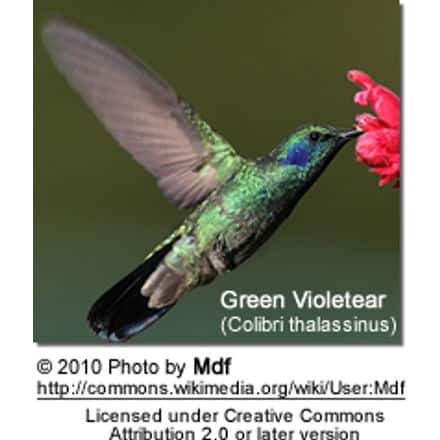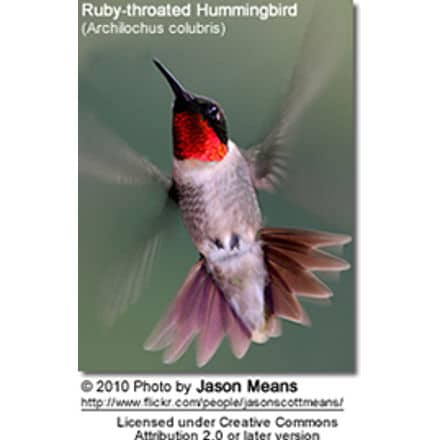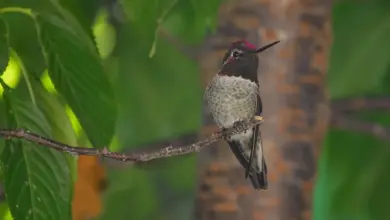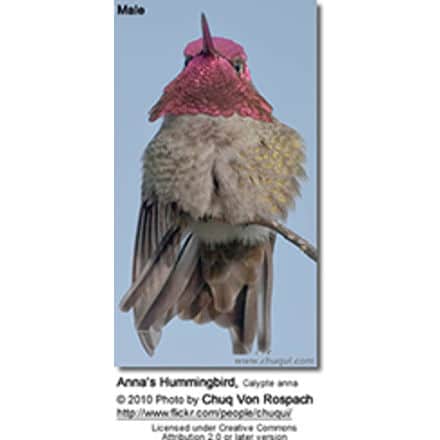Hummingbird Species Found in Mexico
Hummingbirds found in the USA (by U.S. State) … Canada … Mexico … Puerto Rico … Jamaica … Honduras
Lucifer Hummingbirds (Calothorax or Trochilus lucifer) – Natives
ID: Large head. Bill is thin and down-curved. Body is small andtapered. Wings small. Tail long, narrow and deeply forked, extending well beyond the wingtips. Forehead is green and the back is a drab grey-green. There is a pale buffy band across the chest. Distinctive white streak behind the eyes.
The male has a glossy magenta to blue-violet throat patch (gorget) that is elongated at the sides and is bordered white on both sides (note: the purple gorget looks black in poor light). The neck and the chest are white. The under plumage is whitish / greyish with greenish and rusty sides.
The female is larger in size, lacks the flashy throat patch of the male, and is light brown around the chest and throat area.
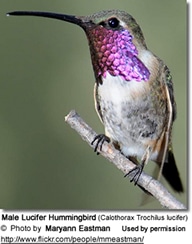
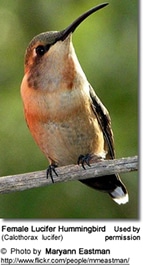
Long-tailed Hermits (Phaethornis superciliosis) – Also found in Central and South America
Little Hermits (Phaethornis longuemareus) – Also found in Central and South America
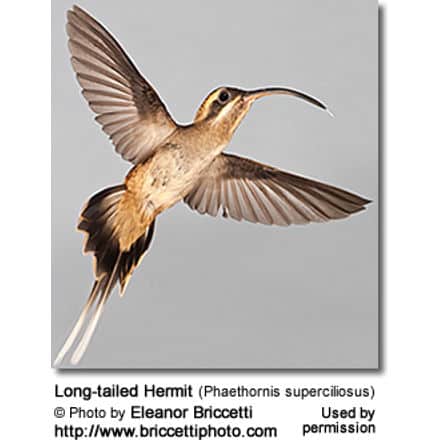
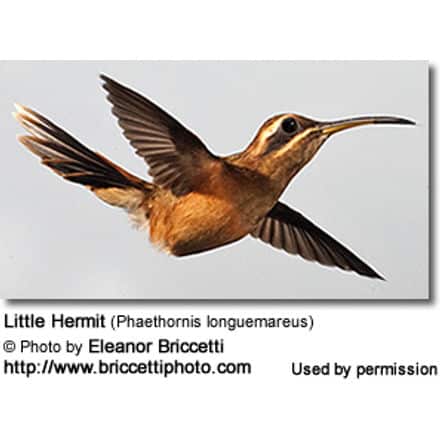
Wedge-tailed Sabrewings (Campylopterus curvipennis) – Also found in Central America
Violet Sabrewings (Campylopterus hemileucurus) – Also found in Central America

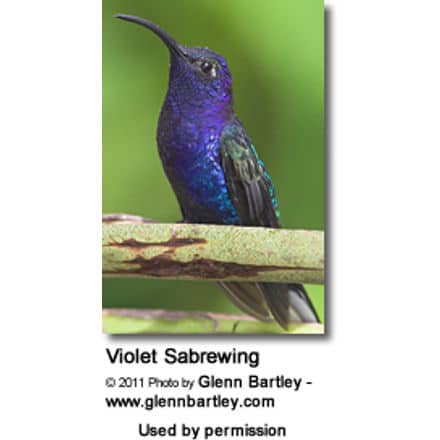
White-necked Jacobins (Florisuga mellivora) – Also found in Central and South America
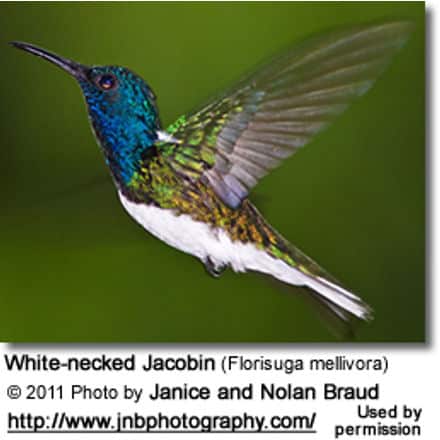
Green Violetear Hummingbirds (Colibri thalassinus) – Also found in Central and South America
Green-breasted Mangos (Anthracothorax prevostii) – Also found in Central America
Emerald-chinned Hummingbirds (Abeillia abeillei) – Also found in Central America
Blue-throated Sapphire or Blue-Throated Goldentail, Hylocharis eliciae


Rufous-crested Coquettes (Lophornis delattrei) – Also found in Central and South America
Black-crested Coquettes (Lophornis helenae) – Also found in Central America
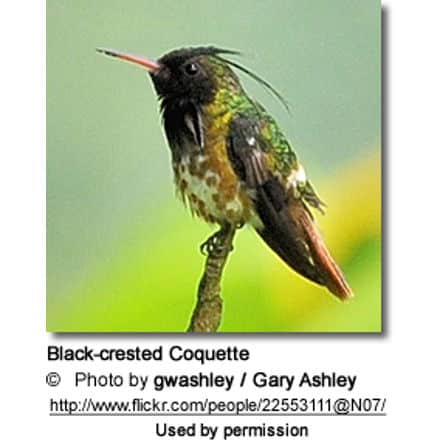
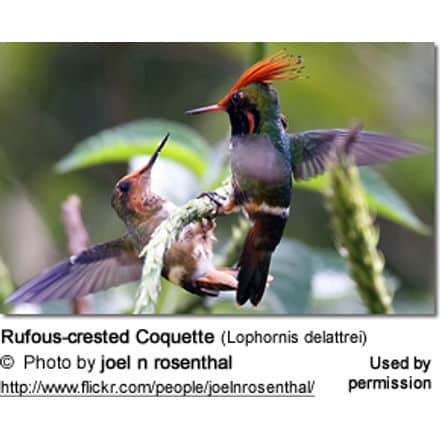
Fork-tailed Emeralds or Canivet’s Emeralds (Chlorostilbon canivetii) — Also found in Central and South America
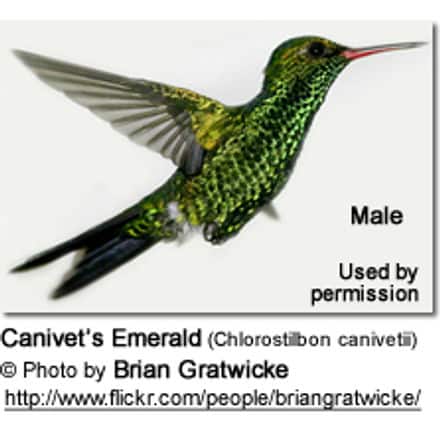
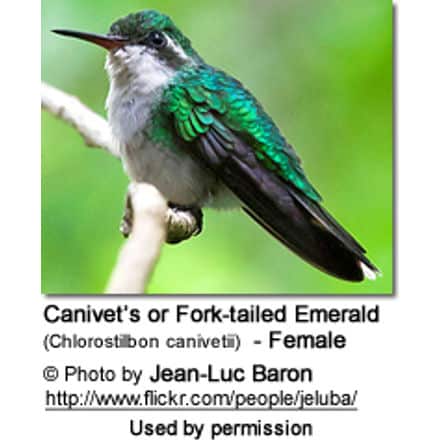
Dusky Hummingbird (Cynanthus sordidus)
Broad-billed Hummingbirds (Cynanthus latirostris) – Also found in United States (Arizona, New Mexico, Texas)
The male is glossy green above and on the chest. He has a deep blue throat. His straight and slender beak is red with a black tip. His slightly forked tail is dark above, and the under tail feathers are white.
The female is less colorful than the male. Her throat, chest and belly are light to medium grey. She has a white stripe over each eye.


Mexican or Crowned Woodnymphs (Thalurania ridgwayi) – Also found in Central and South America
Xantus’s Hummingbirds (Basilinna xantusii) – Rare vagrants / breeders. These Mexican hummingbirds have been venturing into southern California on a regular basis and some nesting activities having been reported. Some travel up the Pacific coast of North America to British Columbia in Canada.
ID: Can readily be identified by their white eyestripes, with a black eyestripe below. Head and back is mostly greenish. Below they are cinnamon. Tail is straight and dark-colored. Males have green throats; brownish in the females. Males have red, black-tipped beaks; females blackish.


White-eared Hummingbirds (Basilinna leucotis) – Also found in United States (Arizona) and Central America
ID: Both the male and female White-eared Hummingbird have a prominent white ear stripe (more boldly colored in the male) for which this species was named.
Blue-throated Sapphire or Blue-Throated Goldentail, Hylocharis eliciae – Also found in Central and South America
White-bellied Emerald, Amazilia candida – Also found in Central America
Stripe-tailed Hummingbird (Eupherusa eximia) – Also found in Central America
Blue-capped Hummingbird or Oaxaca Hummingbird, Eupherusa cyanophrys – Only found in southernmost portion of the Sierra Madre del Sur in the Mexican state of Oaxaca
White-tailed Hummingbird, Eupherusa poliocerca – Only found in the westernmost portion of the Sierra Madre del Sur in Guerrero and extreme western Oaxaca, Mexico
Azure-crowned Hummingbird, Amazilia cyanocephala – This dominant hummingbird species is usually found in highland areas with pine or oak forests, humid broadleaf forest and the La Mosquitia pine savanna.
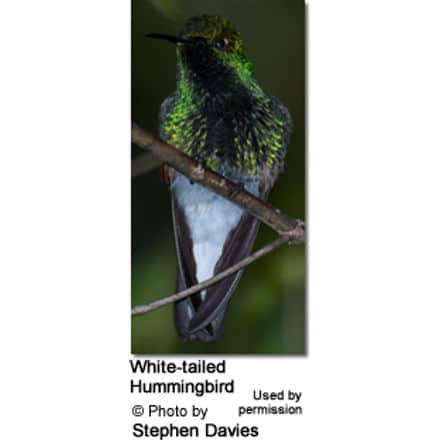
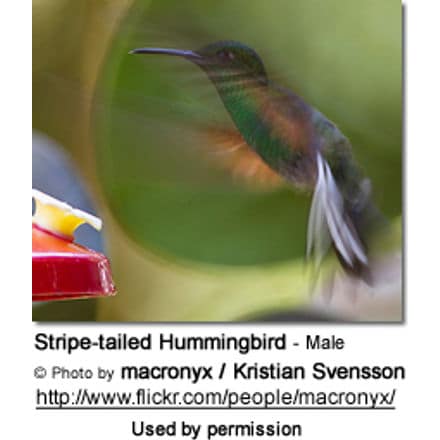
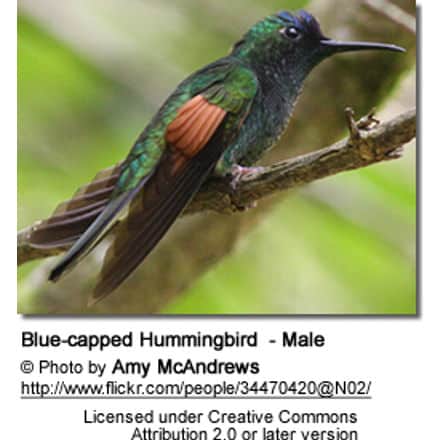
(Amazilia beryllina ssp. viola) – Native, Rare, and local summer residents. Occur in the Ramsey Canyon, Miller Canyon, Cave Creek Canyon, Madera Canyon, and Chiricahua National Monument (Chiricahua, Santa Rita, and Huachuca Mountains) of southeastern Arizona. Mostly found in pine-oak woodland and sycamore streamside forest in mountain canyons. They nest from July through September.
ID: They have shimmering green feathers from their bill to their rump, where the color changes to rufous and extends through their tail feathers.
The tail feathers have a shiny, iridescent purple tint that blends with the rufous color.
Males and females look alike.
(Amazilia rutila) – Also found in Central America and rarely in the US.
ID: This medium-sized hummingbird is bronze-green above and cinnamon-colored below. The square tail is reddish with gold and green edging. The long, slim bill has a black tip. Males and females look alike.
Buff-bellied Hummingbird (Amazilia yucatanensis) – Also found in the United States (Texas) and Central America (Belize only)
Rufous-tailed Hummingbird (Amazilia tzacatl) Also found in Central and South America
Violet-crowned Hummingbirds (Amazilia violiceps) – Common in Mexico, where their range extends down the Pacific slope from Sonora through Jalisco to northwestern Oaxaca and in the interior Madrean Highlands from western Chihuahua south through Durango to Oaxaca. Also wander into southern parts of the United States, where they have been reported in California, Arizona, New Mexico, Texas, and Virginia.
ID: This hummingbird is most easily identified by its white under plumage and iridescent bluish-violet crown (from where it gets its name). The back is emerald green. The tail is dark brown/olive green. The straight and very slender bill is reddish / orangey with a black tip.
Females and juvenile birds look similar to the males, but their plumage is generally less colorful than that of the male and they have a lighter and greener crown.
Green-fronted Hummingbird (Amazilia viridifrons)
Blue-throated Hummingbirds (Lampornis clemenciae) – Also found in the United States (Arizona, New Mexico, Texas)
The upper plumage is dull green, fading to a medium grey on the underside. It has white stripes behind the eyes and a narrower stripe extending backward from the corner of its relatively short bill, next to a blackish cheek patch.
The male can be identified by the iridescent blue throat patch (gorget), which may appear black or grey color in poor light.
The female and young have grey throats.
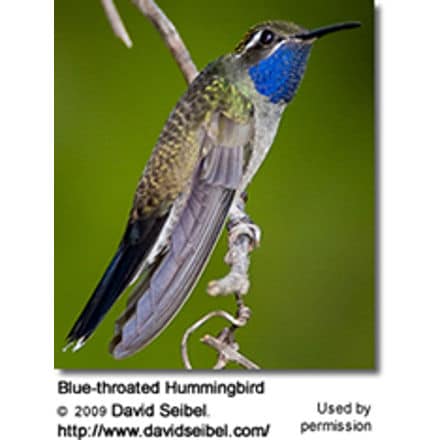
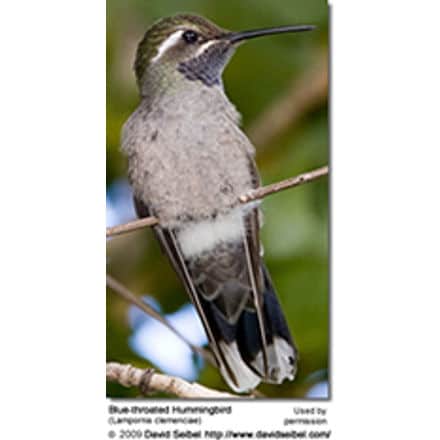
Amethyst-throated Hummingbird (Lampornis amethystinus) – Also found in Central America
Garnet-throated Hummingbird (Lamprolaima rhami) – Also found in Central America
Magnificent or Refulgent Hummingbirds (Eugenes fulgens) – Also found in the United States (Arizona and New Mexico)
They are nearly twice as large as any other hummingbird species found in this State, and can often be identified by their size alone.
The male has a metallic green throat and a black chest. His forehead and crown are purple and the back is dark green.
The female plumage is less bright. Her chest is solid grey. Her back and crown are olive green. Her tail feathers are pearl-grey tipped.
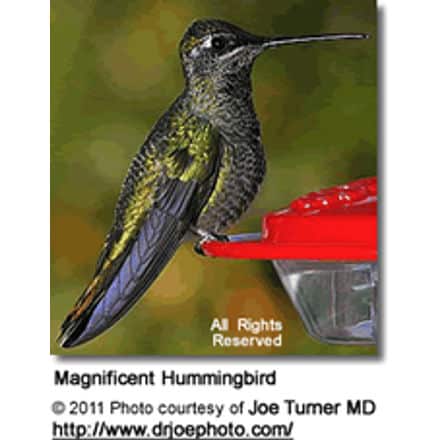
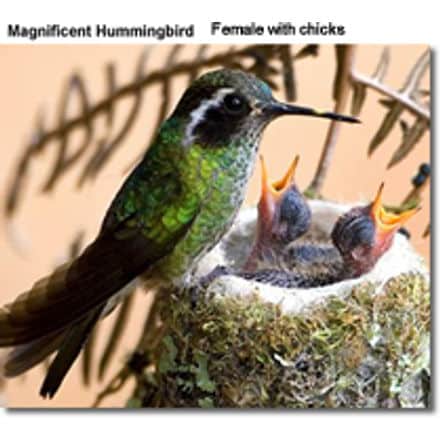
Plain-capped Starthroat (Heliomaster constantii) – Also found in Central America
Long-billed Starthroat (Heliomaster longirostris) – Also found in Central and South America
Mexican Sheartail (Tilmatura eliza)
Sparkling-tailed Hummingbirds (Tilmatura dupontii) – also known as Sparkling-tailed Woodstar– They are easily identified by the male’s blue throat patches, white collars around their necks and the long, checkered tails. They are most common in western Mexico to northern Nicaragua.
Beautiful Hummingbird (Calothorax pulcher)
Ruby-throated Hummingbirds (Archilochus colubris) – Also found in the eastern United States and southern Canada. Winters in Mexico and Central America
The male has a ruby-red throat, a white collar, an emerald green back, and a forked tail.
The female has a green back and tail feathers that are banded white, black, and grey-green.
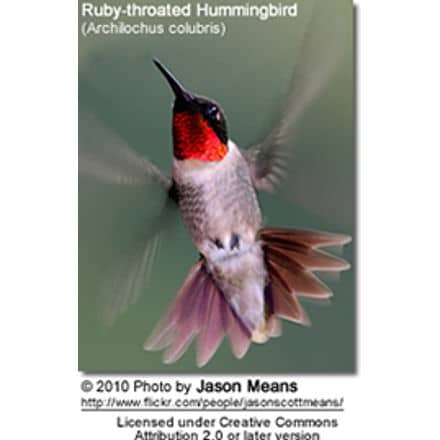
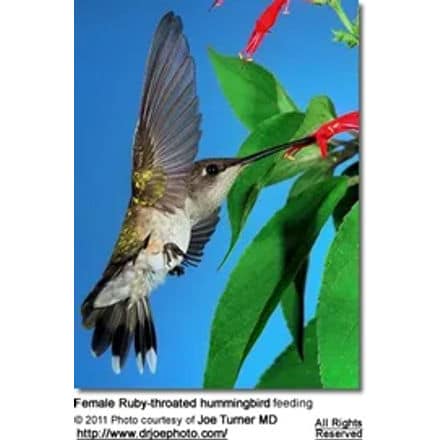
Black-chinned Hummingbirds (Archilochus alexandri) – Also occurs in the Western United States
The male has a black, shimmering throat with a purple edge and pale feathers below that create a collar. However, unless the light is just right, the head looks all black. His back is green and there are some green feathers covering the chest.
The female is pale below (sometimes with a slightly speckled throat) and her back is green.
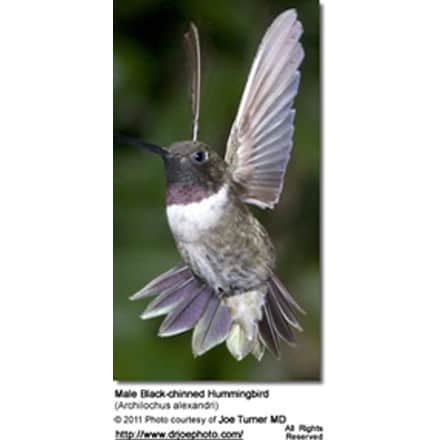

Anna’s Hummingbirds (Calypte anna) – Also found in Western coastal United States
One of the largest and the most vocal hummingbirds in the United States, it is the only species to produce a song; specifically the males produce a complex series of scratchy noises, sounding like a sharp “chee-chee-chee; when moving from flower to flower, they emit toneless “chip” vocalizations. All other hummingbirds in the United States are mostly silent.
They are well known for their territorial behavior; the male makes elaborate dive displays at other birds and sometimes even at people. At the bottom of their dives, they produce high-pitched loud popping sounds with their tail feathers.
Males have glossy dark rose-red throats and crowns, which may appear black or dark purple in low light. The underside is mostly greyish; and the back metallic green.
Females have light grey chests with white and red spotting on the throat, greenish back, and white-tipped tails.
They resemble the Costa Hummingbirds, but the male Costa’s Hummingbird’s gorget (throat feathers) is longer than that of the Anna’s. They are larger than the Rufous Hummingbirds and lack the rusty coloration of the Rufous Hummingbirds.
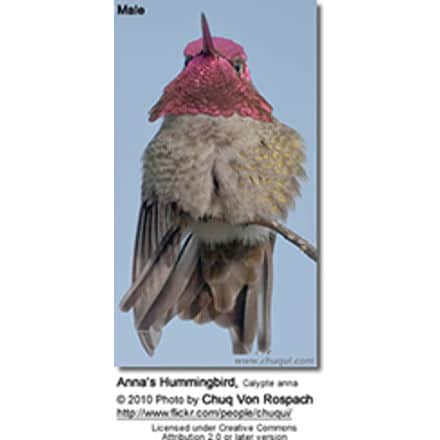
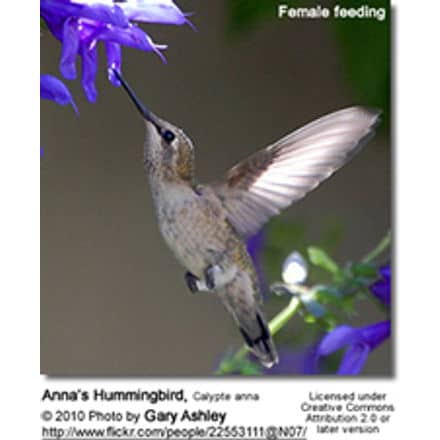
Costa’s Hummingbirds (Calypte costae) – Also found in western coastal United States
Males can easily be identified by the glossy purple crown and long, conspicuous throat feathers that project markedly down the side of the throats, giving it an elongated “mustache” appearance. The back is metallic green.
Females have greyish-green crowns (top of the head) and backs. The chin and the plumage below are whitish, except for some black spotting on her throat. Her flanks are buffy-colored. She has a dark tail with white tips on the outer tail feathers.
They resemble Anna’s Hummingbirds, but the male’s gorget (throat feathers) is longer than that of Anna’s.

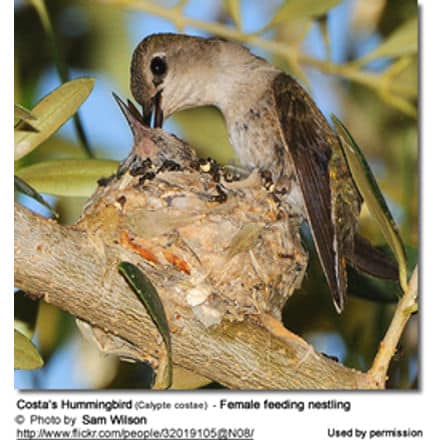
Calliope Hummingbirds (Stellula calliope) – Also found in western United States and Canada
The smallest breeding bird in North America. They are most easily confused with the Rufous Hummingbirds and the Broad-tailed Hummingbird.
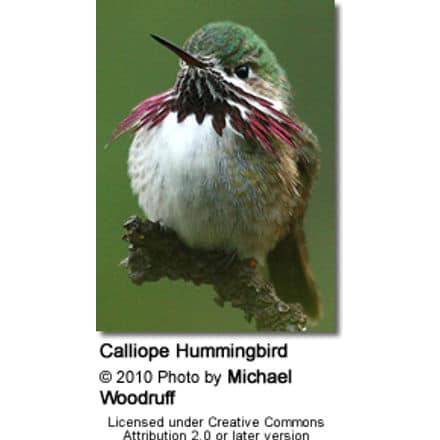
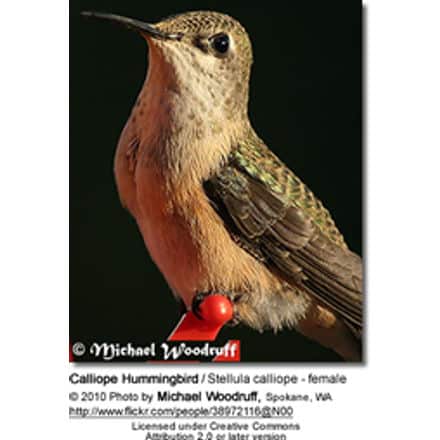
Bumblebee Hummingbirds (Atthis heloisa) – Also found in Central America and rarely in the U.S. (Arizona)
The upper plumage and sides are mostly green. The plumage below is whitish. The rounded tail is green with a rufous base.
The male can be identified by the violet-red gorget (throat patch).
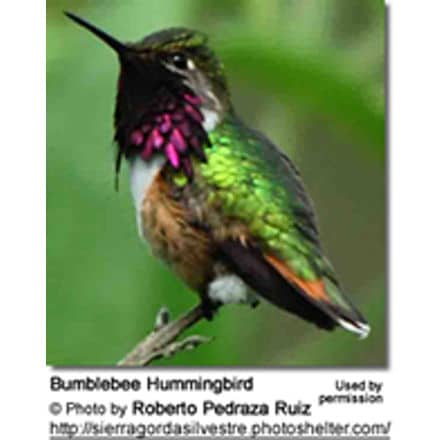
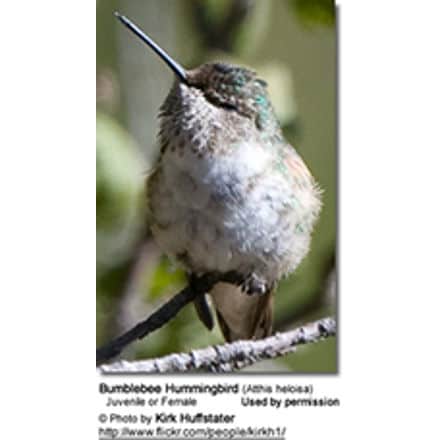
Broad-tailed Hummingbirds (Selasphorus platycercus) – Also found in western United States and Central America
Males can most easily be identified by their iridescent, rose-red throats, white chest feathers and metallic green back and crown and their rounded tails. The males’ tails make whistling noises in flight.
Females lack the flashy throat patch of the male and are mostly pale below. Their white-tipped outer tail feathers are rust-colored close to the body and blackish in the center; the tail feathers in the center range from green to blackish.

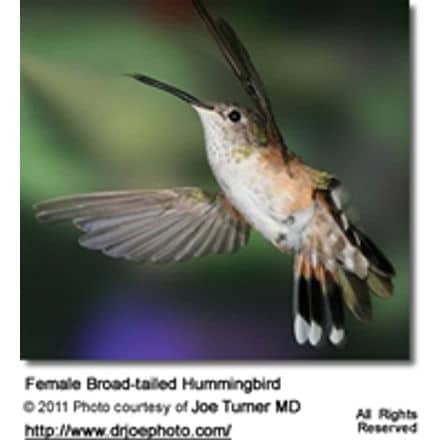
Rufous Hummingbirds (Selasphorus rufus) – Also found in Canada and United States
Males can easily be identified by their glossy orange-red throats.
Females have whitish, speckled throats, green backs and crowns, and rufous, white-tipped tail feathers.

Allen’s Hummingbirds (Selasphorus sasin) – Also found in western coastal United States
They are almost impossible to distinguish from Rufous Hummer unless it is an adult male. The Allen’s can be identified by the green back whereas the adult Rufous has a coppery back.
The male has a throat that ranges in color from orange-red to yellow-orange, a back that is bright green, a rump that is rufous and its tail feathers are rufous tipped in black.
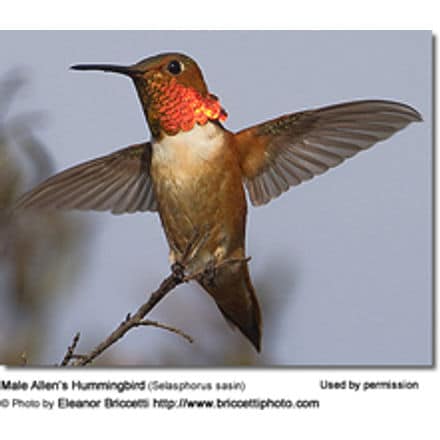
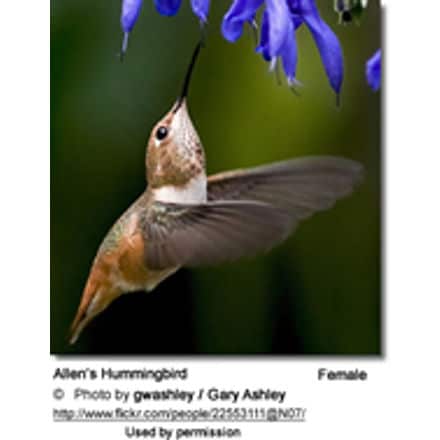
Hummingbird Resources
- Hummingbird Information
- Hummingbird Amazing Facts
- Attracting Hummingbirds to Your Garden
- Hummingbird Species
- Feeding Hummingbirds

